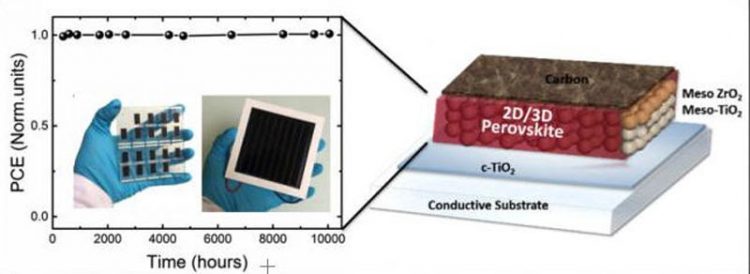Ultra-stable perovskite solar cell remains stable for more than a year

This is a schematic representation of the findings of this study. Credit: MK Nazeeruddin/EPFL
The lab of Mohammad Khaja Nazeeruddin at EPFL in collaboration with Michael Grätzel and Solaronix company has engineered what is known as 2D/3D hybrid perovskite solar cell. This combines the enhanced stability of 2D perovskites with 3D forms, which efficiently absorb light across the entire visible spectrum and transport electrical charges.
In this way, the scientists were able to fabricate of efficient and ultra-stable solar cells, which is a crucial step for upscaling to a commercial level. The 2D/3D perovskite yields efficiencies of 12.9% (carbon-based architecture), and 14.6% (standard mesoporous solar cells).
The scientists built 10×10 cm2 solar panels using a fully printable industrial-scale process. The resulting solar cells have now delivered a constant 11.2% efficiency for more than 10,000 hours, while showing zero loss in performance as measured under standard conditions.
The breakthrough resolves the problem of perovskite solar-cell stability, and can viably move the technology into the commercial sphere.
###
This work was funded by the Marie Curie Institute, the Horizon 2020 program, the European Union Seventh Framework Programme (FP7/2007-2013) and Solaronix.
Reference
G. Grancini, C. Roldán-Carmona, I. Zimmermann, E. Mosconi, X. Lee, D. Martineau, S. Narbey, F. Oswald, F. De Angelis, M. Graetzel, M.K. Nazeeruddin. One-Year stable perovskite solar cells by 2D/3D interface engineering. Nature Communications 01 June 2017. DOI: 10.1038/ncomms15684
Media Contact
All latest news from the category: Materials Sciences
Materials management deals with the research, development, manufacturing and processing of raw and industrial materials. Key aspects here are biological and medical issues, which play an increasingly important role in this field.
innovations-report offers in-depth articles related to the development and application of materials and the structure and properties of new materials.
Newest articles

A ‘language’ for ML models to predict nanopore properties
A large number of 2D materials like graphene can have nanopores – small holes formed by missing atoms through which foreign substances can pass. The properties of these nanopores dictate many…

Clinically validated, wearable ultrasound patch
… for continuous blood pressure monitoring. A team of researchers at the University of California San Diego has developed a new and improved wearable ultrasound patch for continuous and noninvasive…

A new puzzle piece for string theory research
Dr. Ksenia Fedosova from the Cluster of Excellence Mathematics Münster, along with an international research team, has proven a conjecture in string theory that physicists had proposed regarding certain equations….



